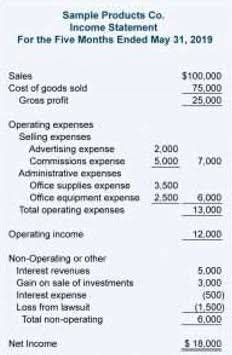
Functional expenses in your organization are reported by their functional classification and recorded in your Statement of Functional Expenses (SFE). Your SFE is one of the four main statements you’ll utilize in your nonprofit, which also includes your Statement of Activities. A more extensive estimation process is required for expenses that cannot be tied back to a specific program or support service (e.g., payroll costs, depreciation, occupancy, and repairs and QuickBooks maintenance). The most common benchmarks to allocate these expenses are time and effort for payroll costs and square footage for occupancy costs.
- For example, “salary” is a straightforward line-item on a for-profit financial report.
- The new standard changes expense reporting in a few ways for not-for-profits.
- For additional guidance on accurately reporting your functional expenses, reach out to your local Blue & Co. advisor today.
- This helps in understanding the allocation of the money as well as in keeping a track of the direction and achievement the organization is making towards the end goal.
- Direct costs are those that relate to only one classification such as meals provided for an after-school program or rent for a building that is solely used for providing a specific program.
- Nonprofits should strive to allocate most of their expenses to programs costs, provided these expenses are allocated properly and are aligned with the nonprofit’s mission.
Expensify’s role in expense categorization:
Nonprofits have unique reporting requirements that set them apart from for-profit businesses. Beyond compliance, there are other reasons why organizations should care about tracking functional expenses. A nonprofit accountant creating a functional expense report for a nonprofit business first needs to classify each expense by its functional classification. While nonprofit functional Accounting for Churches expenses may be easily categorized, there are a few allocation methods that nonprofit organizations can use to build their functional expenses report.
Statement of Cashflows:

Non-profit organizations most widely use this form of reporting expenditure. If putting together your nonprofit’s statement of functional expenses – and other related financial documents – is overwhelming or intimidating, book a call to see how ModVentures can help you in your mission today. The easiest way to start an allocation is by first identifying expenses incurred for a specific program or support service — they’ll be allocated directly. For instance, a food bank that incurs costs to transport food items will allocate the total transportation amount to program services. Program expenses are any costs related to running the various programs and services offered by a nonprofit organization, as per its mission.
What is a Statement of Functional Expenses?

Like a business issues Business Statement, a nonprofit has to issue an Activity Statement. This statement records all the expenses, costs, and revenue generated by the nonprofit organization in a given period of time. This helps in recording and keeping a track of all the expenses and income statements that the nonprofit experiences. This helps in understanding the allocation of the money as well as in keeping a track of the direction and achievement the organization is making towards the end goal. As we have discussed above, a nonprofit has to record all its expenses in classifications.

A nonprofit has to mandatorily record all the expenses in natural as well as functional expenses accounts. The most expenses made by a nonprofit are for salaries, benefits, and employment taxes. As per Financial Accounting Standards Board’s requirement, a nonprofit organization is supposed to categorize the statement of functional expenses expenses on the basis of its purpose.
- The trustees or the fund pairs provide their resources in the form of money to help the organizations achieve this mission.
- Such expenses don’t apply to the non-profit mission, which typically includes costs such as administration, bookkeeping, and governance.
- Tracking and allocating functional expenses is a major bookkeeping challenge for small nonprofits.
- Transparency and accountability are essential to building trust with current donors, potential donors and grantmaking organizations.
- A statement of functional expenses is unique to nonprofits and does not have a parallel report from traditional businesses.
- Functional expenses are simply an allocation of expenses based upon the purpose of the underlying expenditure.
- Direct allocation works best when an organization can link an expense directly to a function.

All costs directly related to delivering programs should be recorded in this category. Ideally, this category would be the most robust on the Statement of Functional Expenses, as donors and investors prefer that nonprofits direct most of their funds towards achieving their stated mission. Nonprofits should strive to allocate most of their expenses to programs costs, provided these expenses are allocated properly and are aligned with the nonprofit’s mission.
